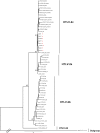High prevalence of human T-lymphotropic virus 2 (HTLV-2) infection in villages of the Xikrin tribe (Kayapo), Brazilian Amazon region
- PMID: 31117977
- PMCID: PMC6532245
- DOI: 10.1186/s12879-019-4041-0
High prevalence of human T-lymphotropic virus 2 (HTLV-2) infection in villages of the Xikrin tribe (Kayapo), Brazilian Amazon region
Abstract
Background: Studies have shown that the human T-lymphotropic virus 2 (HTLV-2) is endemic in several indigenous populations of the Brazilian Amazon and molecular analyses have shown the exclusive presence of HTLV-2 subtype 2c among the indigenous groups of this geographical region.
Methods: The present study characterizes the prevalence of HTLV-2 infection in three new villages of the Xikrin tribe, in the Kayapo group, according to their distribution by sex and age. The study included 263 samples from individuals from the Kateté, Djujeko and Oodjã villages. Plasma samples were tested for the presence of anti-HTLV-1/2 antibodies using enzyme-linked immunosorbent assays (ELISA). Seropositive samples were confirmed using real-time PCR, nested PCR and sequencing.
Results: The serological and molecular results confirmed the sole presence of HTLV-2 in 77 (29%) samples, with a prevalence of 38% among women and 18% among men. In these communities, it was found that the prevalence of HTLV-2 infection increased with age. Nucleotide sequences (642 bp, 5'LTR) from eight samples were subjected to phylogenetic analysis by the neighbor-joining method to determine the viral subtype, which confirmed the presence of HTLV-2c.
Conclusions: The results of the present study establish the presence of HTLV-2 infection in three new villages of the Xikrin tribe and confirm the high endemicity of the infection in the Kayapo indigenous group of the Brazilian Amazon.
Keywords: Brazilian Amazon; HTLV-2; Kayapo; Xikrin.
Conflict of interest statement
The authors declare that they have no competing interests.
Figures


References
-
- Hall WW, Zhu SW, Horal P, Furura Y, Zagaany G, Vahlne A. HTLV-II infection in Mongolia. AIDS Res Hum Retrovir. 1994;10:443. doi: 10.1089/aid.1994.10.443. - DOI
-
- Salemi M, VAN Dooren S, Vandame A. Origin and evolution of human and simian T-cell lymphotropic viruses. AIDS Rev. 1999;1:131–139.
MeSH terms
Grants and funding
LinkOut - more resources
Full Text Sources

